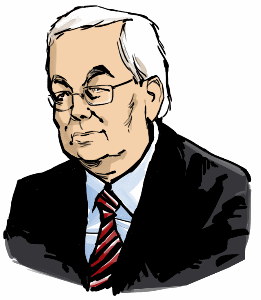Bræðr munu berjask
(Gylfaginning 51. k.)
8301 = Bræðr munu berjask
8582 = ok at bönum verðask,
9707 = munu systrungar
6607 = sifjum spilla,
7493 = hart er með hölðum,
6954 = hórdómr mikill,
7890 = skeggjöld, skalmöld,
7458 = skildir klofnir,
7114 = vindöld, vargöld,
9431 = áðr veröld steypisk.
79537
Með þessu erindi Völuspár kynnir Snorri Sturluson sig til sögunnar sem Spámann af Guðs náð – og er hans þó hvergi getið þar skv. orðanna hljóðan. Í gegnum aldirnar hafa hebreskir fræðimenn rýnt í spásagnir helgibókar Gyðinga, Torah, með tækni sem kallast gematría þar sem einstakir bókstafir hafa fast tölugildi og merking spásagna er lesin úr tölugildum texta viðkomandi spásagna.
Að baki býr hugmynd um Skapandi Mátt (Heimssál Platons) sem Alfa og Omega veraldar. Veröld vísar hér til Manns – ekki veraldar í venjulegri merkingu – sem vaknar til lífs sem Andi og Hold/Jörð. Hjá Shakespeare er Hamlet Danaprins tákngervingur Manns goðsagna á andlegri þroskabraut þar sem vegvísanir Anda og Holds eru einatt misvísandi, sbr. fræga orðræðu Hamlets, To be og not to be, that is the question.
Hamlet kom fyrst fram á sjónarsviðið í Eddu Snorra Sturlusonar sem Amlóði. Enn í dag vísar nafnið til einstaklings sem er ekki skarpasti hnífurinn í skúffunni, sbr. Björn Kaðalsson í Njálu. Hins vegar eru Egill Skalla-Grímsson og Grettir Ásmundarson sögupersónur Snorra og Sturlu Þórðarsonar sem undirstrika tvískipt eðli Manns sem að kjarna til er Andi í Efnislíkama – Manns sem Mann-Skepnu, sbr. Mörður Valgarðsson.
Hér verður ekki orðlengt um þessi flóknu mál, heldur sýnt hvernig Snorri Sturluson getur kynnt sig til sögunnar sem Spámann með tölugildi hins þekkta erindis Völuspár hér að ofan. Aðili sem þekkir hugmyndavefinn að baki textans og telur sig því vita hvað þar kann að vera “hulit kveðit” (hugtak Snorra í 8. k. Skáldskaparmála) er fljótur að álykta að úr honum megi lesa tölugildin 20087 + 11359 + 345 + 4000 + 43746 = 79537.
a. 20087 er tölugildi vísuorðs Virgils sem á miðöldum var talið spá fyrir um Komu Krists:
Magnus ab integro saeclorum nascitur ordo. (The mighty cycle of the ages begins anew.)
b. 11359 = Snorri Sturluson
c. 345 = Heilagur þríhyrningur Íslands í heiðni – tákn Mannssálar skv. Einari Pálssyni.
d. 4000 = Fast tölugildi Logandi Sverðs, sbr. Surtr ferr sunnan með sviga lævi í Völuspá.
e. 43746 = Tölugildi Brennu-Njálssögu – Saga þroskabrautar Mannssálar frá c. til d.
Tölugildi Brennu-Njálssögu = summa tölugilda Alfa og Omega setninga Njálu og Kristniþáttar (100.-105. k.):
6257 = Mörðr hét maðr.
12685 = Höfðingjaskipti varð í Nóregi.
11274 = Fara menn við þat heim af þingi.
13530 = Ok lýk ek þar Brennu-Njálssögu.
43746
Reiknivél sem umbreytir texta í tölugildi er á netinu: http://www.light-of-truth.com/ciphersaga.htm
***
Hér að neðan eru inngangsorð fræðimanns að miklu ritverki, Hamlet’s Mill, um hinn íslenzka Amlóða sem er betur þekktur sem Hamlet Danaprins. Á morgun mun ég setja inn aðra bloggfærslu þar sem tölugildi frásagna Snorra af (i) Sköpun heims í formála Eddu , (ii) Ragnarökum í 51. k. Gylfaginningar, (iii) Heimkomu Ganglera í 54. k., og (iv) siðaskiptum úr Heiðni í Kristni er sýnt vera samtals 878864.
Snorri var brautryðjandi kristinnar útgáfu af meginstefum heiðinna goðsagna sem endurspeglast í Gylfaginningu og þekktasta atriði úr leikriti Shakespeares, The Tragedie of Hamlet, Prince of Denmarke, “To be or not to be, o.s.frv.” Tölugildi þess frá Alfa til Omega er 878864.
***
The Once And Future King
(Giorgio de Santillana)
This is meant to be only an essay. It is a first reconnaissance of a realm well-nigh unexplored and uncharted. From whichever way one enters it, one is caught in the same bewildering circular complexity, as in a labyrinth, for it has no deductive order in the abstract sense, but instead resembles an organism tightly closed in itself, or even better, a monumental „Art of the Fugue.“
The figure of Hamlet as a favorable starting point came by chance. Many other avenues offered themselves, rich in strange symbols and beckoning with great images, but the choice went to Hamlet because he led the mind on a truly inductive quest through a familiar landscape – and one which has the merit of its literary setting. Here is a character deeply present to our awareness, in whom ambiguities and uncertainties, tormented self-questioning and dispassionate insight give a presentiment of the modern mind. His personal drama was that he had to be a hero, but still try to avoid the role Destiny assigned him. His lucid intellect remained above the conflict of motives – in other words, his was and is a truly contemporary consciousness. And yet this character whom the poet made one of us, the first unhappy intellectual, concealed a past as a legendary being, his features predetermined, preshaped by long-standing myth. There was a numinous aura around him, and many clues led up to him. But it was a surprise to find behind the mask an ancient and all-embracing cosmic power – the original master of the dreamed-of first age of the world.
Yet in all his guises he remained strangely himself. The original Amlóði, as his name was in Icelandic legend, shows the same characteristics of melancholy and high intellect. He, too, is a son dedicated to avenge his father, a speaker of cryptic but inescapable truths, an elusive carrier of Fate who must yield once his mission is accomplished and sink once more into concealment in the depths of time to which he belongs: Lord of the Golden Age, the Once and Future King.
This essay will follow the figure farther and farther afield, from the Northland to Rome, from there to Finland, Iran, and India; he will appear again unmistakably in Polynesian legend. Many other Dominions and Powers will materialize to frame him within the proper order.
Amlóði was identified, in the crude and vivid imagery of the Norse, by the ownership of a fabled mill which, in his own time, ground out peace and plenty. Later, in decaying times, it ground out salt; and now finally, having landed at the bottom of the sea, it is grinding rock and sand, creating a vast whirlpool, the Maelstrom (i.e. the grinding stream, from the [Icelandic] verb mala, „to grind“), which is supposed to be a way to the land of the dead. This imagery stands, as the evidence develops, for an astronomical process, the secular shifting of the sun through the signs of the zodiac which determines world-ages, each numbering thousands of years. Each age brings a World Era, a Twilight of the Gods. Great structures collapse; pillars topple which supported the great fabric; floods and cataclysms herald the shaping of a new world. (Hamlet’s Mill – An Essay on Myth and the Frame of Time, 1969; Second Paperback Edition, David R. Godine, Publisher, Boston, 1983, pp. 1-2.)

 Gunnar Tómasson
Gunnar Tómasson